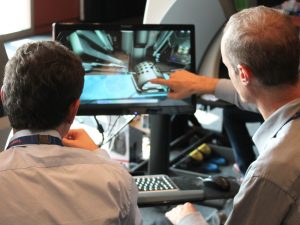The 15th meeting of the EAU Robotic Urology Section began in Marseille on Wednesday, kicking off with a day devoted to the needs of young(er) robotic urologists. The regular programme starts September 6th.
After several shows of hands throughout the morning, it is clear that the adoption of certain concepts discussed at ERUS18 can be improved. Concepts like “the robotic dance”, standardised team briefings before each operation and the ERAS protocol were employed by only a minority of the 88 audience in Marseille.
Dr. Alessandro Larcher (Milan, IT) had the honour of giving the first talk, presenting an overview of robotic training in Europe, specifically the ERUS curriculum that was introduced in 2015. The curriculum combines simulation, console training and a clinical fellowship at one of the 50 ERUS-approved centres. Larcher showed examples of training on artificial models, living porcine models and cadavers. Special attention is also given to decision-making skills, for instance in emergency situations like instrument locks.
An objective evaluation of the first groups of curriculum veterans shows clear technical improvement, which is also translated into a clinical setting. “The ERUS curricula can protect patients from suboptimal outcomes while the surgeon is still learning,” Larcher summarized. “The curricula effectively allow the transition from beginning to independent surgeons. They are also safe as they do not result in any detriment to the clinical outcome.”
ERAS and PROM/PREM
The ERAS protocol [Enhanced Recovery After Surgery] is one of the main themes for ERUS18, with Local Organising Committee Chairman (and de facto host in Marseille) Dr. Jochen Walz having previously expanded on its potential benefits for urologists. In fact, each ERUS18 delegate received the protocol on a USB stick in their congress bag, with the hope that they bring the protocol back to their centres. The protocol can be downloaded here.
Dr. Pavlos Pavlakis (Guildford, GB) presented the protocol at the Junior ERUS-YAU session, particularly how it applies to RARP, RARC and RAPN patients. Around a quarter of the audience already used the protocol. With a new approach to patient prep and post-surgery care, recovery can be improved, shortening hospital stays and improving patient comfort.
“ERAS is evidence-based care improvement for surgical patients. It results in improved outcomes and lower cost, making ERAS an important example of value-based care applied to surgery.”
Dr. Anna Wallerstedt Lantz (Stockholm, SE) spoke on patient-reported outcomes, specifically the concepts of PROM and PREM: “Doctors tend to overestimate the functional recovery of their patients,” Dr. Wallerstedt Lantz began.
“The patient-reported outcome measures [PROM] can serve as a measure of how patients experience their illness and health following treatment. It examines symptoms, functional ability and the health-related quality of life. The patient-reported experience measures [PREM] are the degree to which the patient experienced and is satisfied with the care received.”
Measuring these effectively requires large resources, but it has a positive effect on physician-patient communication and facilitates individual patient decision-making. Wallerstedt-Lantz painted a picture on upcoming integrated systems for the collection of patient-reported outcomes: “These systems combine this with radiology and pathology lab data, giving the physician a complete picture of the patient’s status and experience.”





